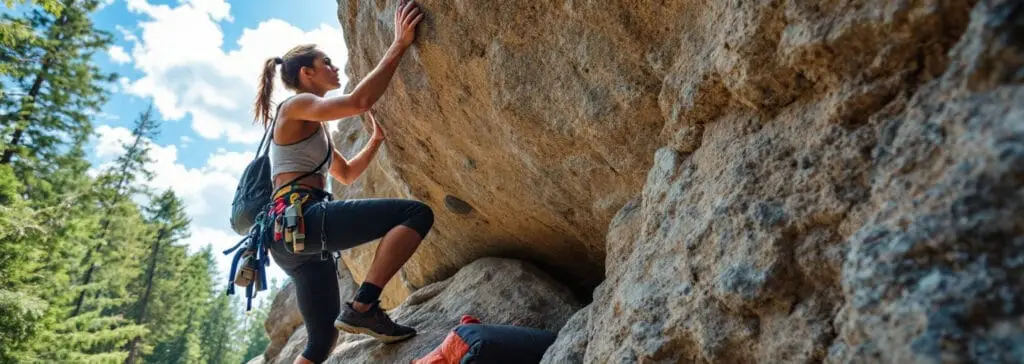Introduction
This guide will provide you with an overview of the essentials of climbing in Fontainebleau. You'll discover :
- The story climbing in this fascinating region
- Visit unique characteristics the rocks of Fontainebleau
- Visit popular sectors to explore
- Visit best times for climbing
- Visit essential equipment to ensure your safety
Whether you're a beginner or an experienced climber, this guide will help you maximize your climbing experience at this iconic site.
Why climb at Fontainebleau?
Fontainebleau is a must-see climbing destination, attracting climbers from all over the world. Located 55km south of Paris, the region is renowned for its sandstone rock formations, offering a variety of challenges suitable for all levels. Fontainebleau's importance to the climbing community cannot be underestimated; with over 25,000 documented routes spread over 200 sectors, it's a veritable playground for enthusiasts.
Fontainebleau is easily accessible from Paris. You can take a direct train from Gare de Lyon to Fontainebleau-Avon, which takes around 40 minutes. Once in Fontainebleau, most climbing sites are within a short drive or walk of the town.
History of climbing in Fontainebleau
Bouldering in Fontainebleau dates back to the 19th century, when Parisian climbers first explored the area. The area first served as a training ground for mountaineers, before becoming a veritable bouldering paradise. Today, the Fontainebleau forest is a revered climbing spot, often referred to simply as "Font" in the global climbing community.
Emblematic figures
A key influence in the development of bouldering in Fontainebleau is Pierre Mazeaud. This mountaineer and writer played a crucial role in promoting climbing in the Fontainebleau forest. His contributions helped establish standards and techniques that are still relevant today.
Evolution and popularity
Over the decades, climbing in Fontainebleau has grown exponentially in popularity. Climbers flocked to this climbing spot to enjoy its unique and varied challenges. The diversity of routes available attracts beginners and experienced climbers alike, reinforcing its status as a must-see destination in the climbing world.
This rich past continues to inspire each new generation of climbers, helping to maintain Fontainebleau as a mecca for the climbing community.
The unique characteristics of the rocks of Fontainebleau
Rock formations in Bleau sandstone are the heart of the Fontainebleau climbing experience. These rocks, shaped by erosion over the centuries, offer a unique terrain for climbers from all over the world. Here are just a few of the features that make this site so world-renowned:
- Texture and adhesion Bleau sandstone has a rough surface for excellent grip. This characteristic enables climbers to execute delicate movements on small holds.
- Variety of circuits Fontainebleau offers over 25,000 documented routes, each with its own unique challenges. Circuits range from the simplest to the most technical, offering a wide range of experiences for all levels.
- Block types Boulders at Fontainebleau vary in size and shape. Some boulders are massive, while others are smaller but just as demanding. Each boulder has its own personality, making each climb unique.
- Specific challenges The Fontainebleau Boulder Climb: climbers can encounter a variety of challenges such as overhanging passages, tricky traverses and dynamic movements. These features make bouldering in Fontainebleau a rewarding experience.
Fontainebleau is not only a climbing paradise, it's also a natural treasure trove. The forest extends over 280 square kilometers and is home to a rich biodiversity. Climbers often find themselves immersed in lush greenery, sandy soils and picturesque clearings, giving them a sense of adventure in a peaceful natural setting.
Popular climbing areas in Fontainebleau
Fontainebleau is home to several emblematic climbing sectors, attracting climbers of all levels. Among them, these 6 sectors stand out for their varied offerings.
Three Gables
- Options for all levels This sector offers around 60 circuits, ranging from beginners to advanced.
- Child-friendly tours The white-marked routes enable young climbers to discover climbing in complete safety.
Roche aux Sabots
- Diversified circuits With a multitude of boulders, this sector is also suitable for experienced climbers wishing to take on more demanding challenges.
- Friendly atmosphere The climbing community often gathers here, creating a warm and welcoming environment.
Franchard Isatis
Franchard Isatis is one of the most popular sectors, known for its diversity of problems. You'll find a wide range of difficulties, from easy slabs for beginners to more complex overhangs. Its location in a picturesque part of the forest makes it a favorite with locals and visitors alike.
Bas Cuvier
Considered the cradle of bouldering in Fontainebleau, Bas Cuvier is emblematic. It's home to some of the forest's toughest problems, with climbs ranging from Fontainebleau grades 3 to 8. For experienced climbers looking for technical challenges, this is the place to be.
Apremont
Apremont is perfect for climbers looking for a peaceful, less crowded experience. It features more isolated boulders and is an ideal spot for a quiet day out. You'll encounter large sandstone boulders, most of which have a lower difficulty level, making Apremont ideal for intermediate climbers.
The Elephant
Named after its elephant-shaped rock formation, L'Elephant is a fun area with a variety of technical climbs. The area is particularly interesting for photographers because of the unique shapes and textures of the rocks.
These areas make Fontainebleau an unmissable climbing destination. Whether you're a novice or an expert, you'll find challenges to suit your skills. The magnificent scenery and unique atmosphere add to the overall climbing experience.
Best times to climb in Fontainebleau
The best time to boulder in Fontainebleau is during the cooler months. Autumn (September to November) and spring (March to May) offer ideal climbing conditions. Sandstone performs best when dry and cool, giving it maximum grip and friction.
If you can climb in summer, the heat can make the boulders greasy, and winter conditions can bring humidity, limiting your possibilities.Here are some key points to consider:
- Cool temperatures for better grip on rock.
- Less rain Dry days are more frequent, reducing the risk of slippery conditions.
Before each climbing session, it's crucial to check the weather conditions.
Here are the Fontainebleau weather conditions hour by hour and for the next 8 days

- Temperature
- Precipitation
- Rain Chance
- Wind
- Humidity
- Pressure
Rain can have a significant impact on the condition of sandstone, making it brittle and susceptible to deterioration. To plan your outing, consult a climbing map Fontainebleau and keep up to date with forecasts.
Climbing in Fontainebleau is a unique experience. Choosing the right time to go will maximize your enjoyment and safety on these famous climbing spots.
Essential climbing equipment for a safe experience in Fontainebleau

When preparing to climb in Fontainebleau, the right equipment is crucial to guarantee your safety and optimize your performance. Here's a list of essential equipment:
- Climbing shoes Choose shoes with good support and maximum grip on sandstone.
- Crashpad Crashpad: indispensable for protecting your falls. A good crashpad absorbs impact and reduces the risk of injury when climbing.
- Magnesia Helps keep your hands dry, improving your grip on small holds.
These elements are essential if you are to enjoy climbing to the full in complete safety. By investing in quality equipment, you'll increase your confidence and pleasure when climbing in this exceptional setting.
Access to climbing areas: practical tips for getting to Fontainebleau
For how to get to Fontainebleauseveral means of transport are available:
- By car Easy access via the A6 freeway. Several parking lots are available near popular areas.
- By train From Fontainebleau-Avon: regular trains run from Paris Gare de Lyon to Fontainebleau-Avon station. A short bus or bike ride then takes you to the various climbing sites.
- By bike The region is well served by cycle paths, making it easy to get to the areas and enjoy the scenery at the same time.
Rules for camping and fires
It is important to respect certain rules to preserve this exceptional natural environment:
- Camping is prohibited in the forest.
- Fires are not allowed in the forest to avoid any risk of fire.
Labels and preservation
The beauty of Fontainebleau lies not only in its boulders, but also in the forest that surrounds them. Climbers must therefore respect etiquette in order to preserve the environment for future generations:
- Stay on designated trails to avoid damaging the forest floor.
- Clean up after yourself: Always pick up after yourself and minimize the use of chalk.
- Avoid climbing on wet rock: this can damage fragile sandstone and increase erosion.
These rules guarantee the protection of the magnificent climbing sites in Fontainebleau, enabling climbers to enjoy their experience to the full.
Guide to using climbing topos in Fontainebleau: maximize your sessions with these indispensable resources
Use a topo is essential to optimize your climbing sessions in Fontainebleau. Here's how:
- Choosing the right topo Fontainebleau: look for recent topos, ideally in PDF format, available online or in local bookshops. A good climbing Fontainebleau PDF contains precise information on routes and levels of difficulty.
- Session planning The best way: browse the guidebook to select sectors suited to your level. The guidebooks often indicate the color of the markers corresponding to difficulty, making it easier to select routes.
- The importance of local guides For beginner climbers, we strongly advise you to rely on the expertise of local guides. They provide invaluable advice on technique, equipment and safety.
By using these resources wisely, you guarantee a safe and rewarding climbing experience in Fontainebleau.
Diving into the heart of Fontainebleau's climbing community: clubs, events and collective spirit
Visit climbing community in Fontainebleau is vibrant and dynamic, supported by several clubs that play a key role. These include French Alpine Club distinguishes itself by promoting local climbing and organizing regular outings for all levels.
Emblematic events such as La Tribune Libre de Bleau reinforce this collective spirit. This event encourages climbers to get together, share their experiences and discover new routes together.
Community initiatives are not limited to competitions; they generate a real network of mutual support and learning. Experienced climbers take pleasure in guiding beginners, helping to create a welcoming and inclusive atmosphere in this renowned destination.
Conclusion: the irresistible appeal of climbing in Fontainebleau!
The appeal of climbing in Fontainebleau is undeniable. This iconic destination offers a unique experience in the heart of nature, surrounded by exceptional rock formations.
- Whether you're a beginner or an experienced climber, Fontainebleau promises unforgettable adventures.
- The dynamic community and regular events further reinforce this collective spirit.
You are warmly invited to explore this fascinating region and experience your own unforgettable climbing adventure!
FAQ
The history of climbing in Fontainebleau dates back to the 1950s, when the first climbers began exploring the region's sandstone rock formations. Since then, Fontainebleau has become an iconic site for climbers from all over the world.
Fontainebleau is home to several iconic climbing sectors, including Trois Pignons and Roche aux Sabots. These sectors offer a variety of boulders suitable for all skill levels.
To get to Fontainebleau, there are several means of transport available: car, train or bus. It's advisable to check timetables and itineraries to choose the best option for your point of departure.
The best times to climb in Fontainebleau are generally from spring to autumn, with ideal conditions in May and September, when the weather is mild and crowds are smaller...
For a safe experience in Fontainebleau, it's essential to have climbing shoes, a crash pad to cushion falls, weather-appropriate clothing and possibly a brush to clean holds.
Using a guidebook is essential to optimize your climbing sessions in Fontainebleau. These guides provide information on the boulders, their difficulty and practical advice on approach and safety.

